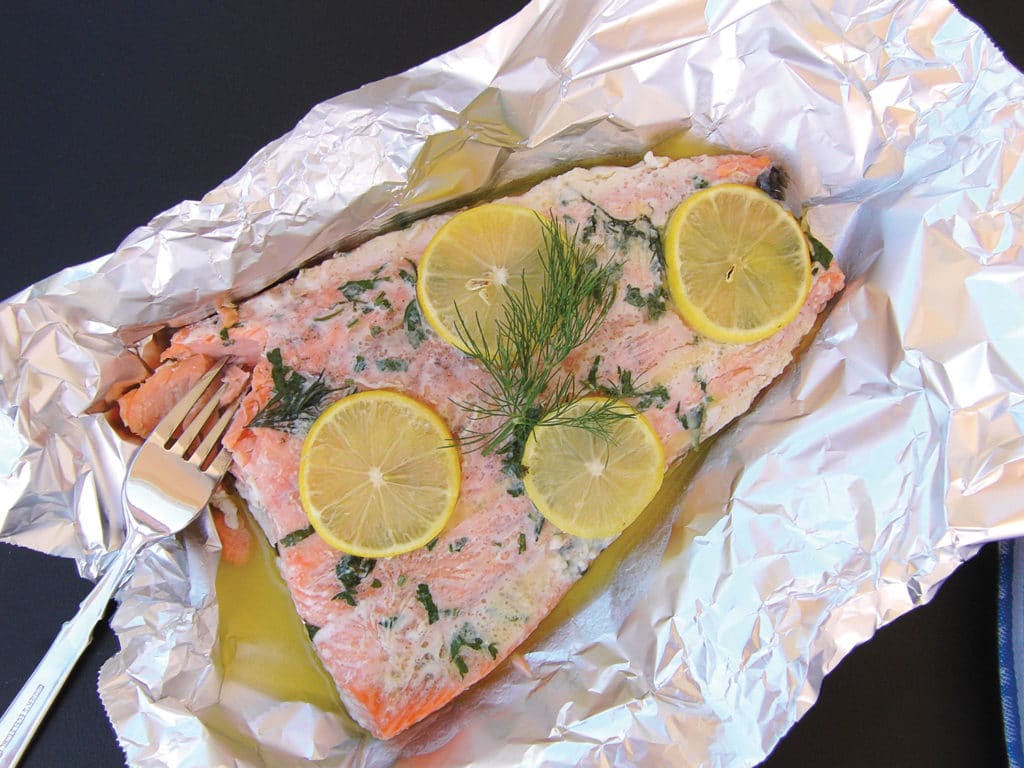
Not much beats a freshly caught Alaskan salmon for dinner. One of my favorite feelings is to be happily tired after a full day’s casting at the mouth of a river, and rowing back to our wooden cutter, Celeste, with a bucketful of delectable fish. Our dinner on the evening of a fishing day is almost always the same: simple and delicious. Since we want to bring out the flavor—not cover it up—we almost always grill our fresh fillets on our Dickinson SeaBQ, seasoned lightly with only salt, pepper, dill and local wild beach parsley (when we find it). Topped with a couple of pats of butter and lemon slices, it’s ready to grill. (Wrapping fillets in aluminum foil saves on pan cleanup and prevents fish from sticking to the grill.) Served with rice or new potatoes, a green vegetable or a green salad, and maybe a Kodiak Brewing Company IPA, it makes a perfect finish to a great day of Alaskan wilderness cruising.
Grilled Salmon with Citrus Butter
2 small or 1 large fillet fresh salmon
1/2 tsp. salt (or to taste)
1/2 tsp. pepper (or to taste)
1 tsp. dried dill weed (or a few sprigs fresh)
2 Tbsp. butter
1-2 lemons or limes, sliced into rounds
1 Tbsp. parsley, chopped (optional)
Serves 2
Preheat grill to medium-high (390 to 400 degrees F). Lightly oil a large piece of heavy-duty aluminum foil. Lay salmon fillets on foil skin side down. Sprinkle with salt, pepper, dill and/or parsley. Add a tablespoon of butter to each fillet. Lay on 4 lemon or lime rounds. Crimp or fold foil edges so fish is enclosed. Lay foil packet on the grill. Close grill cover and cook for 15 to 20 minutes. Cooking times may vary by several minutes depending on fillet thickness and approximate temperature of the grill (which also tends to vary). Fish is done when fillet feels a bit firm, not squishy, when pressed with the tines of a fork, and flesh flakes apart easily at thickest part of fillet, or when an instant-read thermometer reads 145 degrees F. For best results, test at 15 minutes and continue cooking a few minutes at a time until done. Note: Salmon continues cooking for a few minutes after removal from heat, so it’s better to remove too early than too late!
If you don’t have a stern grill, or the weather’s inclement, this can also be done in the oven. Quick tip: Allow about 4 to 6 minutes cooking time per half-inch of salmon thickness at 400 degrees F.
Wild Beach Parsley (Ligusticum scoticum)
Also known as wild celery, beach lovage, or qanisan in Aleut, this Arctic plant has three serrated leaves and grows along rocky shorelines. It’s best harvested when the shoots are still tender, and can be used cooked or raw with fish and in soups, spring rolls and salads. Be careful when foraging: Don’t mistake poison hemlock for the beach parsley; the flowers look similar, but the leaves of hemlock are more feathery than the edible qanisan. If you’re in doubt, don’t eat it.








